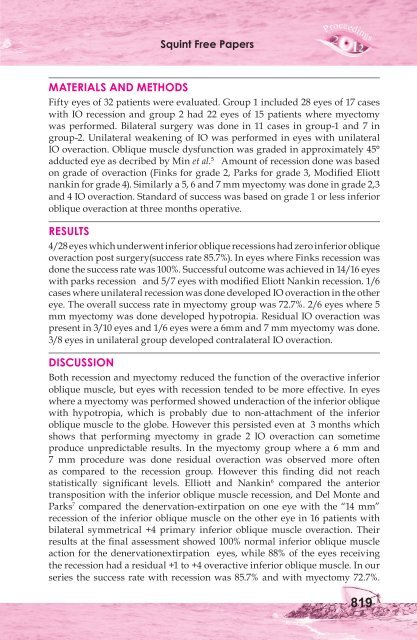Squint Free Papers - aioseducation
Squint Free Papers - aioseducation
Squint Free Papers - aioseducation
Create successful ePaper yourself
Turn your PDF publications into a flip-book with our unique Google optimized e-Paper software.
<strong>Squint</strong> <strong>Free</strong> <strong>Papers</strong><br />
MATERIALS AND METHODS<br />
Fifty eyes of 32 patients were evaluated. Group 1 included 28 eyes of 17 cases<br />
with IO recession and group 2 had 22 eyes of 15 patients where myectomy<br />
was performed. Bilateral surgery was done in 11 cases in group-1 and 7 in<br />
group-2. Unilateral weakening of IO was performed in eyes with unilateral<br />
IO overaction. Oblique muscle dysfunction was graded in approximately 45°<br />
adducted eye as decribed by Min et al. 5 Amount of recession done was based<br />
on grade of overaction (Finks for grade 2, Parks for grade 3, Modified Eliott<br />
nankin for grade 4). Similarly a 5, 6 and 7 mm myectomy was done in grade 2,3<br />
and 4 IO overaction. Standard of success was based on grade 1 or less inferior<br />
oblique overaction at three months operative.<br />
RESULTS<br />
4/28 eyes which underwent inferior oblique recessions had zero inferior oblique<br />
overaction post surgery(success rate 85.7%). In eyes where Finks recession was<br />
done the success rate was 100%. Successful outcome was achieved in 14/16 eyes<br />
with parks recession and 5/7 eyes with modified Eliott Nankin recession. 1/6<br />
cases where unilateral recession was done developed IO overaction in the other<br />
eye. The overall success rate in myectomy group was 72.7%. 2/6 eyes where 5<br />
mm myectomy was done developed hypotropia. Residual IO overaction was<br />
present in 3/10 eyes and 1/6 eyes were a 6mm and 7 mm myectomy was done.<br />
3/8 eyes in unilateral group developed contralateral IO overaction.<br />
DISCUSSION<br />
Both recession and myectomy reduced the function of the overactive inferior<br />
oblique muscle, but eyes with recession tended to be more effective. In eyes<br />
where a myectomy was performed showed underaction of the inferior oblique<br />
with hypotropia, which is probably due to non-attachment of the inferior<br />
oblique muscle to the globe. However this persisted even at 3 months which<br />
shows that performing myectomy in grade 2 IO overaction can sometime<br />
produce unpredictable results. In the myectomy group where a 6 mm and<br />
7 mm procedure was done residual overaction was observed more often<br />
as compared to the recession group. However this finding did not reach<br />
statistically significant levels. Elliott and Nankin 6 compared the anterior<br />
transposition with the inferior oblique muscle recession, and Del Monte and<br />
Parks 7 compared the denervation-extirpation on one eye with the “14 mm”<br />
recession of the inferior oblique muscle on the other eye in 16 patients with<br />
bilateral symmetrical +4 primary inferior oblique muscle overaction. Their<br />
results at the final assessment showed 100% normal inferior oblique muscle<br />
action for the denervationextirpation eyes, while 88% of the eyes receiving<br />
the recession had a residual +1 to +4 overactive inferior oblique muscle. In our<br />
series the success rate with recession was 85.7% and with myectomy 72.7%.<br />
819

















